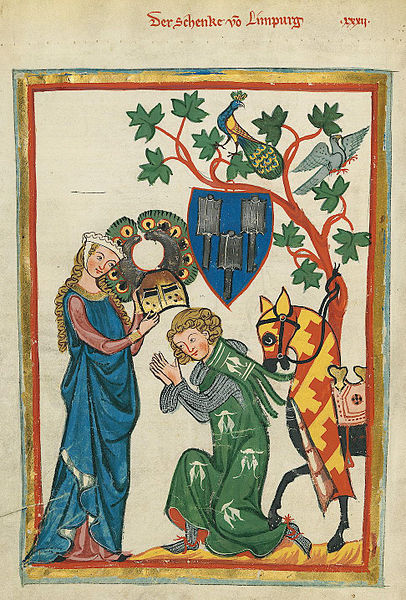A tournament, or tourney, was a chivalrous competition or mock fight in the Middle Ages and Renaissance, and is a type of hastilude. Tournaments included mêlée, hand-to-hand combat, contests of strength, accuracy, and sometimes jousts. Although some thought that the tournaments were a threat to public order, the shows were still often held to celebrate coronations, marriages of notable figures, births, recent conquests, peace treatises; to welcome those considered of great importance, such as ambassadors and lords; or for no particular reason at all, and simply for entertainment. Certain tournaments are depicted throughout the Codex Manesse.
An early 14th century depiction of mounted combat in a tournament from the German Codex Manesse.
Two teams stand ready just before the match begins; each side has 24 knights, each with a banner-bearer. There is a central spectators' box for the four judges, and one on each side for the ladies; inscribed over the boxes is plus est en vous which is the motto of the Gruuthuse family of Bruges.
A tournament in progress (René d'Anjou), only the banners of Bourbon and Brittany are shown left in the field of view. The individual knights' banners are seen to the right.
The joust outlasted the tournament proper and was widely practiced well into the 16th century (sketch by Jörg Breu the Elder, 1510).
Chivalry, or the chivalric language, is an informal and varying code of conduct developed in Europe between 1170 and 1220. It is associated with the medieval Christian institution of knighthood, with knights being members of various chivalric orders; knights' and gentlemen's behaviours were governed by chivalrous social codes. The ideals of chivalry were popularized in medieval literature, particularly the literary cycles known as the Matter of France, relating to the legendary companions of Charlemagne and his men-at-arms, the paladins, and the Matter of Britain, informed by Geoffrey of Monmouth's Historia Regum Britanniae, written in the 1130s, which popularized the legend of King Arthur and his knights of the Round Table.
Konrad von Limpurg as a knight being armed by his lady in the Codex Manesse (early 14th century)
God Speed by English artist Edmund Leighton, 1900: depicting an armoured knight departing for war and leaving his beloved
Reconstruction of a Roman cavalryman (eques)
Knights of Christ by Jan van Eyck








